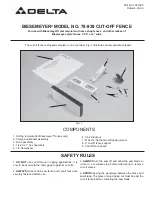
38
Pellerin Milnor Corporation
1. Adjust for maximum rod travel.
a. Operate the master switch to energize control power.
b. Make sure that the air pressure that releases the brake (
Figure 11: A Typical First and Sec-
ond Brake on a Divided Cylinder Machine, page 39
, item 1) is 85 -100 PSI (5.95 - 07.0
kg/cm-cm).
c. Make sure that the nuts that lock the rods together (
, item 5) are loose.
d. Release the brake (see
: Operation of Brake Systems, page 38
). Let the air cylinder rod
fully retract into the air cylinder as shown in
, item A.
e. Turn the brake rod into the air cylinder rod until the brake rod comes out of the brake cyl-
inder fully. See
, item B.
f.
Lock the brake rod (
, item 2) to the air cylinder rod (
, item 3) with two
nuts (
, item 5).
2. Make sure that the brake will continue to operate while the pads wear.
a. Release the brake. On the view slot, put a mark at the position of the lock nuts. (
, item M1).
b. Apply the brake. See
: Operation of Brake Systems, page 38
c. Put a mark at the position of the lock nuts when the brake is applied. This can be at posi-
tion M2a, M2b, or between M2a and M2b. When the pads wear, this position will move.
d. Make sure that the distance the rod moves when you apply the brake is 0.75 to 1.0 inches
(19-25 mm). If the travel is more than this, the brake piston can hit the mechanical stop
before the brake engages fully. This condition is shown in
, item E (dimension
TT).
Operation of Brake Systems
BNWUUM03.T06 0000277789 A.3 A.7 3/17/20 11:57 AM Released
Look at the electrical schematics of your machine to find how your brake is controlled. Some ma-
chines release the brake when you close the door. Some machines have a control relay to release
or apply the brake.
How to Apply the Brake for Machines with a "Break Release" Output
BNWUUM03.T07 0000279004 A.3 A.7 A.2 3/17/20 11:57 AM Released
1. Turn the "brake release" control output off to de-energize the air valve to remove air pressure
to the air cylinder (
Figure 5: A typical hydraulic brake system, page 29
, item 1).
2. With no air pressure, a spring in the air cylinder will apply force to the hydraulic cylinder
(
Figure 5: A typical hydraulic brake system, page 29
, item 8). This will apply pressure to the
brake pads (
Figure 6: The Caliper Components, page 32
, item 4) against the rotor disk (
ure 5: A typical hydraulic brake system, page 29
, item 5). (
tween the Brake Rod and the Air Cylinder, page 37
, item C,D)
NOTE:
If electrical power or compressed air is missing, hydraulic pressure will ap-
ply the brake.
Summary of Contents for 42044SR2
Page 2: ......
Page 9: ...1 General Service Information Pellerin Milnor Corporation 7 ...
Page 23: ...This page intentionally blank ...
Page 43: ...2 Safety Related Components Assemblies Pellerin Milnor Corporation 41 ...
Page 51: ...3 Drive Assemblies Pellerin Milnor Corporation 49 ...
Page 59: ...Pellerin Milnor Corporation 57 Drive Base 5 Sheets 4244SP2 SM Single Motor Drive Assemblies ...
Page 87: ...This page intentionally blank ...
Page 111: ...This page intentionally blank ...
Page 114: ...112 Pellerin Milnor Corporation 6 Shell and Door Assemblies ...
Page 124: ...122 Pellerin Milnor Corporation 7 Control and Sensing Assbmlies ...
Page 128: ...126 Pellerin Milnor Corporation 8 Chemical Supply Devices ...
Page 129: ...This page intentionally blank ...
Page 136: ...134 Pellerin Milnor Corporation 9 Water and Steam Piping and Assemblies ...
Page 137: ...This page intentionally blank ...
Page 154: ...152 Pellerin Milnor Corporation 10 Pneumatic Piping and Assemblies ...
















































